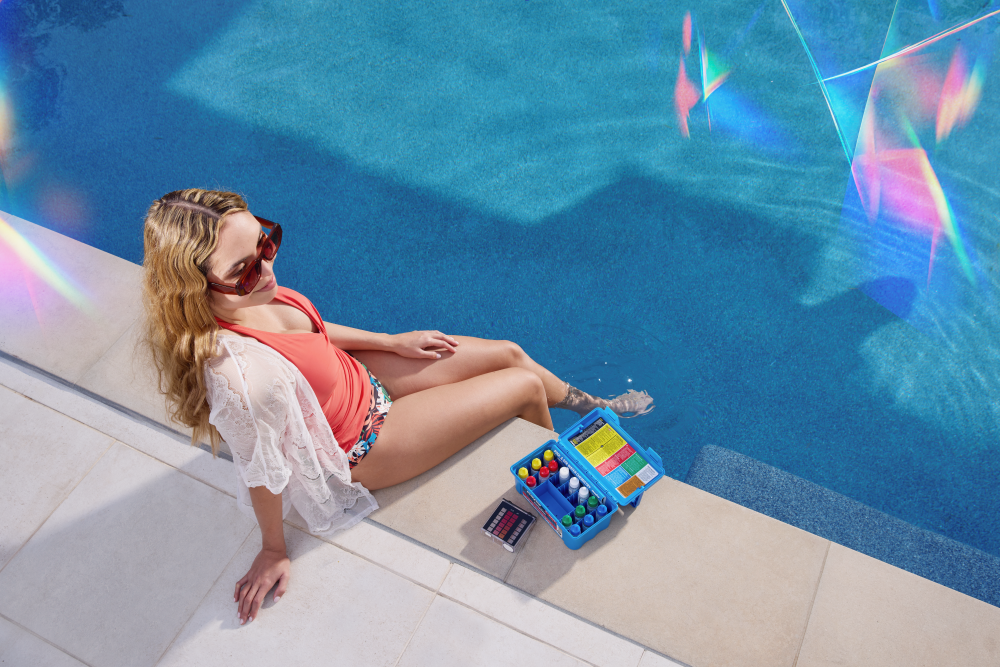Water quality factors can exceed the testing ranges provided in manufacturers' test kits. Chlorine, bromine, pH and cyanuric acid can all exceed the ranges within the popular Taylor Complete™ Series Test Kits: K-2005 series and K-2006 series.
There are three different types of tests employed in these kits. Colorimetric tests for chlorine and bromine using liquid DPD reagents and pH using phenol red, may be thought of as one group. Titrimetric tests for chlorine and bromine using DPD powder and FAS-DPD reagent, along with tests for total alkalinity and calcium hardness, can be considered a second group. The Turbidimetric test for cyanuric acid (CYA) stands alone as the third type.
In the colorimetric tests for chlorine, bromine and pH, the most frequent problem encountered is a level above or below the range provided by the color standards.
Colorimetric Tests for Chlorine or Bromine
In a DPD test for chlorine or bromine, any value that exceeds the highest color standard on the comparator cannot be reported accurately. That’s when a dilution is required. On our 2000 Series™ comparator, there are markings at 1.8 mL, 4.5 mL, and 9 mL on the small comparator tube. A test is normally performed using a 9 mL water sample. However, if the reading is off-scale, an approximate value can be obtained by retesting with a 4.5 mL sample and adding chlorine- or bromine-free water to the 9 mL mark for a 1:1 dilution.
Perform the test again by capping the comparator and inverting it twice to allow for complete mixing of the additional water and sample. Next, add the reagents. Because you have used only half the amount of sample water in this dilution, you must multiply the result by 2. If the value is still off-scale, thoroughly rinse and fill the sample cell to the 1.8 mL mark with sample water, and add chlorine- or bromine-free water to the 9 mL mark for a 1:4 dilution. To obtain the approximate value you must multiply the result by 5.
Colorimetric Tests for pH
When testing pH, a dilution is not the answer since the introduction of different water, likely with a different pH, will produce inaccurate results. The pH range provided in all of our Complete Series Test Kits is 7.0 to 8.0. If the pH level is higher than 8.0 or lower than 7.0, the Acid or Base Demand reagents provided with the kits should be used to determine the proper amount of treatment product required to obtain the desired pH. Tables D, E, and F in the Pool & Spa Water Chemistry booklet can be used along with the amount of Acid or Base Demand reagent dispensed in the test to determine the amount of treatment product needed to bring the pH of your water to the proper level. Introducing smaller doses over time instead of applying the entire portion all at once will prevent damage to surfaces and equipment.
Titrimetric Tests for Chlorine and Bromine
The drop-count method used in the FAS-DPD titration for chlorine and bromine can have some testing limitations. Using more than 50 drops of titrant can create a testing error that is too large to provide a reliable result. If a significant number of drops are needed, you should re-test using a 10 mL sample size. But first, be sure to thoroughly rinse the comparator. For FAS-DPD the drop equivalence is: 0.2 ppm per drop for a 25 mL sample 0.5 ppm per drop for a 10 mL sample.
Turbidimetric Test for CYA
A turbidimetric test is employed to determine cyanuric acid (CYA) levels in an outdoor pool or spa. When added to a sample, the test reagent reacts with the CYA present to form a precipitate in an amount proportional to the CYA level. The treated sample is then slowly dispensed into the comparator tube until the black dot on the bottom of the tube disappears from view when looking down into the tube. The volume of sample is compared to a scale on the side of the tube to determine the level of CYA in the water. The scale used in marking the comparator tube is logarithmic, which means the closer you get to 100 ppm of CYA, the less treated sample is needed to make the black dot disappear. Unfortunately, there is very little distance from the 100 ppm mark to the bottom of the comparator tube, making CYA levels over 100 ppm impossible to read.
For CYA levels at or above 100 ppm, a dilution is required to obtain a more accurate reading. In a container, mix one part sample water with one part CYA-free water (tap or bottled water will do). Retest and multiply the result by 2. If the result is still too high, do another dilution, this time using one part sample water to two parts CYA-free water, and multiply the result by 3.
For questions regarding when or how dilutions should be used in pool and spa water testing, contact Taylor Technical Support.

